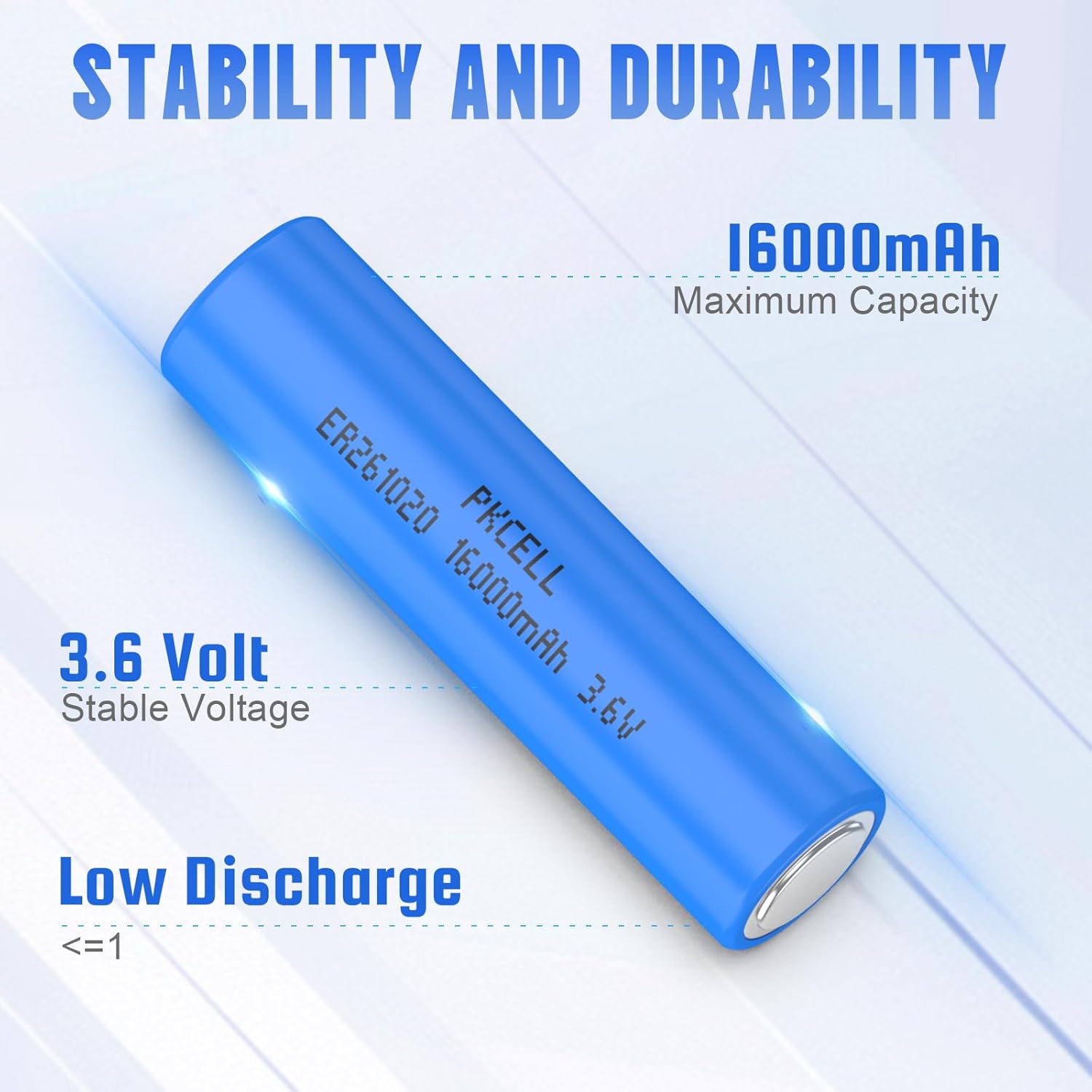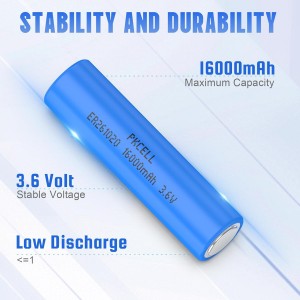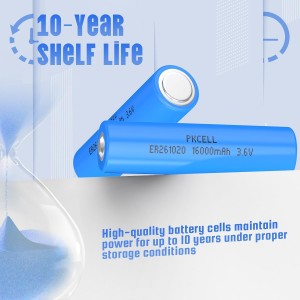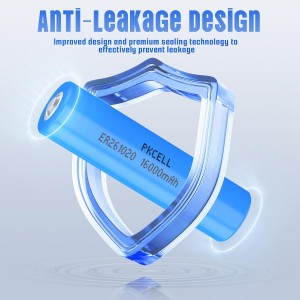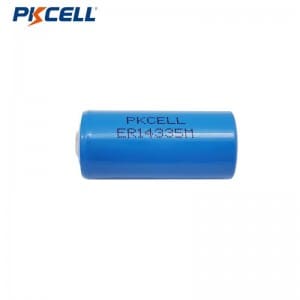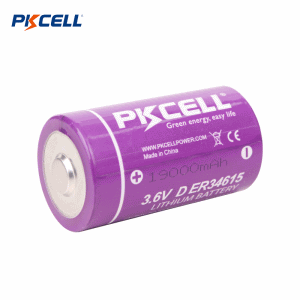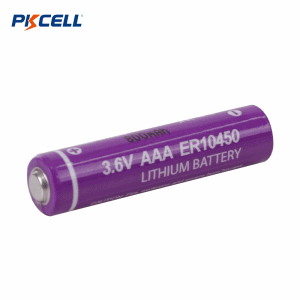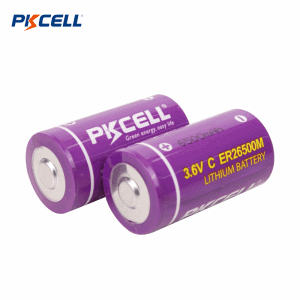3.6V CC ER261020 Li-SoCL2 Battery (16000mAh) | Pkcell
Understanding ER261020 Battery
The ER261020 is a non-rechargeable lithium thionyl chloride (Li-SOCl2) battery. It is commonly known as a Double C size battery. It provides a stable voltage of 3.6V and a high capacity of 16,000, making it ideal for long-life applications. This battery is widely used in industrial settings, particularly for powering horizontal drilling transmitters and locators. You will also find it uesd in intelligent instruments, alarm systems, security devices, and memory backup systems. Its robust design allows for operation in a wide temperature range, from -55°C to +85°C, and it boasts a long shelf life of up to 10 years due to its low self-discharge rate.
Key Features of Pkcell ER261020
- High and Stable Voltage
- High Minimum Voltage During Pulsing
- Stainless Steel Container
- Hermetic Glass-to-metal Sealing
- Low Self-discharge Rate (Less than 1% After 1 year of Storage at +25℃)
- Wide Operating Temperature (-60℃~+85℃)
- Restricted for transport(class 9)
Main Applications of Pkcell ER261020
- Gas Metering
- Utility Metering
- Alarms and Security Devices
- Memory Back-up
- Tracking Systems
- Professional Electronics
Specification Of Other Li-SOCl2 Models
| Model IEC | Nominal Voltage | Dimensions | Nominal Capacity | Standard Current | Max Continuous Discharge Current | Max Pulse Discharge Current | Cut-off Voltage | Weight Approx | Operating Temperature | |
|---|---|---|---|---|---|---|---|---|---|---|
| ER10450 | AAA | 3.6 | 10.0×45.0 | 800 | 1.00 | 50 | 60 | 2.00 | 9 | -55~+85 |
| ER14250 | 1/2AA | 3.6 | 14.5×25.0 | 1200 | 0.50 | 20 | 45 | 2.00 | 10 | -55~+85 |
| ER14335 | 2/3AA | 3.6 | 14.5×33.5 | 1650 | 0.70 | 75 | 150 | 2.00 | 13 | -55~+85 |
| ER14505 | AA | 3.6 | 14.5×50.5 | 2400 | 1.00 | 100 | 200 | 2.00 | 19 | -55~+85 |
| ER17335 | 3.6 | 17×33.5 | 2100 | 1.00 | 100 | 200 | 2.00 | 30 | -55~+85 | |
| ER17505 | 3.6 | 17×50.5 | 3400 | 1.00 | 100 | 200 | 2.00 | 32 | -55~+85 | |
| ER18505 | A | 3.6 | 18.5×50.5 | 4000 | 1.00 | 120 | 200 | 2.00 | 32 | -55~+85 |
| ER26500 | C | 3.6 | 26.2×50.5 | 8500 | 2.00 | 130 | 300 | 2.00 | 55 | -55~+85 |
| ER34615 | D | 3.6 | 34.2×61.5 | 19000 | 3.00 | 200 | 400 | 2.00 | 107 | -55~+85 |
| ER9V | 3.6 | 26.2×50.5 | 8500 | 2.00 | 130 | 300 | 2.00 | 55 | -55~+85 | |
More Than Just Individual Cells - We Offer Complete Power Solutions.
- Single Battery With Cables and Connectors
- Custom LiSOCl2 Battery Packs Based on Your Tailored Needs

Why Choose Pkcell Battery?
Frequently Asked About LiSoCl2 Battery
- Lead Time: Standard samples typically arrive in 7-12 days. Formal orders usually take around 25 days, though smaller quantities might ship faster, potentially within 15-18 days.
- Payment Methods: We accept various payment types, including T/T (Telegraphic Transfer), L/C (Letter of Credit), and PayPal.
- Shipping: We offer flexibility! Depending on your needs and location, we can ship your order via air freight (using carriers like FEDEX, DHL, UPS, EMS, etc.) or via sea freight.
- Delivery Terms: We can work with several common international shipping terms, including EXW, FCA, FOB, CFR, and DDU.
We have a minimum order value of USD $500. The actual quantity you receive depends on the unit price of the specific batteries you choose. Absolutely! We understand you need to test our products. We're happy to provide samples for your evaluation before you place a formal order.
Passivation is an interesting natural phenomenon observed in Lithium Thionyl Chloride (LiSO₂Cl₂) batteries! When lithium metal touches the thionyl chloride (SOCl₂) electrolyte, a thin, protective layer forms on the surface of the lithium negative electrode. This layer, mostly made up of Lithium Chloride (LiCl), creates a high-resistance barrier that prevents a continuous reaction between the lithium and the electrolyte. Isn't it fascinating how this process helps maintain the battery's performance?
Passivation has some excellent benefits along with a few potential drawbacks that are important to consider:
Benefits:
- Low Self-Discharge: The passivation layer does a fantastic job of slowing down any unwanted side reactions between the lithium and the electrolyte, leading to an impressively low self-discharge rate. Thanks to this, LiSO₂Cl₂ batteries can be stored for many years, often over 10 years, while still keeping most of their capacity intact.
- Long Shelf Life: Because of the low self-discharge, these batteries can hold onto their energy for quite an extended period, which is great for long-term storage.
Potential Drawbacks:
- Voltage Delay: When a passivated battery starts discharging—especially after being stored or during high-current pulses—the current first needs to break through or dissolve the high-resistance passivation layer. This can temporarily drop the battery's voltage below its normal operating level before it bounces back. This occurrence is often referred to as "voltage delay."
No, ER261020 batteries are primary (non-rechargeable) Lithium Thionyl Chloride cells. Attempting to recharge them is dangerous and can lead to rupture, fire, or explosion. Once depleted, they must be replaced.
The operational lifespan of an ER261020 battery depends heavily on the specific application, discharge current, and environmental conditions. However, due to their low self-discharge and high capacity, they can last for many years, often 5-10 years or even longer in low-drain applications like utility meters.
While generally safe under normal operating conditions, like all lithium batteries, ER261020 batteries must be handled with care. Key safety considerations include:
- Do not attempt to recharge them.
- Avoid short-circuiting the terminals.
- Do not puncture, crush, or disassemble the battery.
- Store them at recommended temperatures (typically below +30°C) and away from direct heat or open flame.
- Dispose of them properly according to local regulations for lithium batteries.
ER261020 batteries are ideal for applications requiring long-term, reliable power with low discharge rates. Common uses include:
- Memory backup systems
- Real-time clocks (RTCs)
- Utility metering (e.g., smart meters for gas, water, electricity)
- Remote sensors and monitoring devices
- Security systems
- Industrial electronics
- Oil and gas exploration equipment
The ER261020 battery offers several key advantages:
- High Energy Density: It can store a significant amount of energy in a compact size.
- Long Shelf Life: Typically boasts a shelf life of 10-20 years due to its very low self-discharge rate (often less than 1% per year).
- Stable Discharge Voltage: Maintains a consistent 3.6V output throughout most of its lifespan.
- Wide Operating Temperature Range: Can function reliably in extreme temperatures, often from -55°C to +85°C (or even higher for specialized versions).
- Reliability: Excellent for applications where battery replacement is difficult or undesirable.


